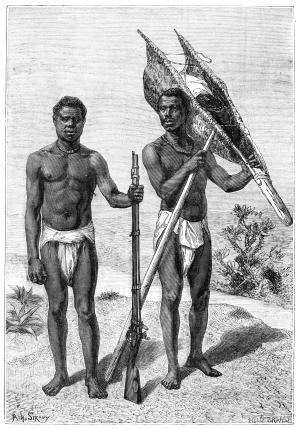A wall painting on a house near Robertsport depicts the motif of a mask dance of the Kru people.
Image & text source: Culture of Liberia
While several distinct ethnic groups have inhabited what is today Liberia for at least a thousand years, no large kingdoms arose there on the lines of those found further east along the coast, like Dahomey, Asante, or the Benin Empire.
Histories of the region, therefore, generally begin with the arrival of the Portuguese traders in the mid-1400s, and the rise of the trans-Atlantic trade. Coastal groups traded several goods with Europeans, but the area became known as the Grain Coast, because of its rich supply malaguetta pepper grains.
Navigating the coastline was not that easy, though, particularly for the large ocean-going Portuguese vessels, and the European traders relied on Kru sailors, who became the primary middlemen in the trade. Due to their sailing and navigation skills, the Kru began working on European ships, including slave trading ships. Their importance was such that Europeans began referring to the coast as Kru Country, despite the fact that the Kru were one of the smaller ethnic groups, amounting to only 7% of Liberia's population today.
In 1816, the future of Kru Country took a dramatic turn due to an event that took place thousands of miles away: the formation of the American Colonization Society (ACS). The ACS wanted to find a place to re-settle free-born black Americans and freed slaves, and they chose the Grain Coast.
In 1822, the ACS founded Liberia as a colony of the United States of America. Over the next few decades 19,900 African-American men and women migrated to the colony. By this time, the United States and Britain had also outlawed the slave trade (though not slavery), and when the American navy captured slave-trading ships, they liberated the slaves on board and settled them in Liberia. Approximately 5,000 African 're-captured' slaves were settled in Liberia.
Image & text source: A Brief History of Liberia

